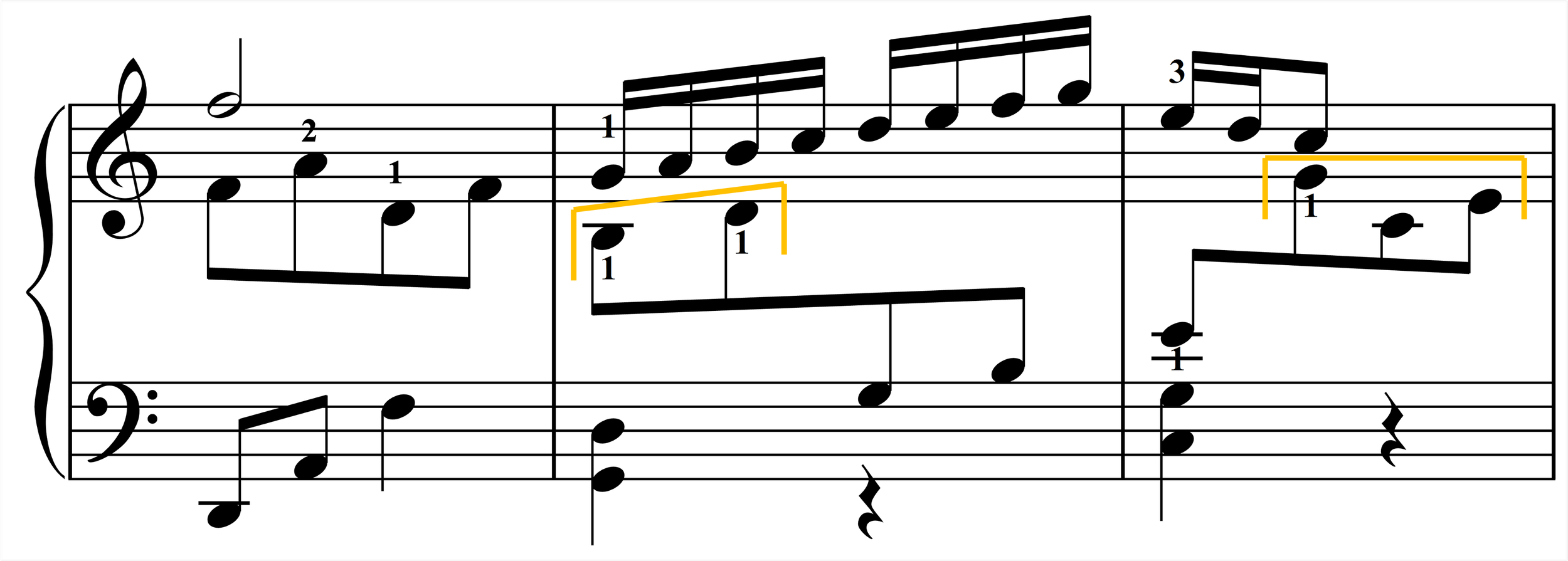“I find it easier to play the scale unencumbered by the alto notes. I play those in the left hand by quickly rolling the chord rather .”
Submitted by Michael Clark
Published on 9/2/2023

“I find it easier to play the scale unencumbered by the alto notes. I play those in the left hand by quickly rolling the chord rather .”
Submitted by Michael Clark
Published on 9/2/2023

“These two notes can be played with the right hand to avoid the need to arpeggiate or stretch in the left hand.”
Submitted by Michael Clark
Published on 9/2/2023

“Though these notes are printed in the top staff, they fit quite easily into the left-hand’s position. I roll the chord at the downbeat of m. 73 and which easily propels my left-hand thumb to hop up to G.”
Submitted by Michael Clark
Published on 9/2/2023

“Splitting the middle voice between the hands in this way reduces position shifts for each hand.”
Submitted by Michael Clark
Published on 10/14/2023

“The intended division of the notes between the hands is unclear in this section. I split them up this way.”
Submitted by Michael Clark
Published on 10/14/2023

“These notes fall naturally into the left hand’s position.”
Submitted by Michael Clark
Published on 9/3/2023

“Taking the C and B with the right hand allows the left hand to sustain the bass note for its full value.”
Submitted by Michael Clark
Published on 10/14/2023

“Taking the E in the right hand assists with maintaining legato in all lines.”
Submitted by Michael Clark
Published on 10/14/2023

“This fingering minimizes the shifts between in each chord in this quick and thickly written passage.”
Submitted by Michael Clark
Published on 10/14/2023

“Taking the first notes of the lower voices in the right hand facilitates a smoother legato in those lines.”
Submitted by Michael Clark
Published on 9/5/2023

“This fingering approach prioritizes a sustained legato melody by transferring some of the alto notes to the left hand.”
Submitted by Michael Clark
Published on 9/6/2023

“I take some of the alto notes into the left hand when they get out of comfortable reach of the soprano line.”
Submitted by Michael Clark
Published on 9/6/2023

“Taking a few of the left-hand notes in the right hand helps these quick-moving chords to feel more secure.”
Submitted by Michael Clark
Published on 9/6/2023

“I find playing the final chord with two thumbs provides both the greatest security and the most brilliant sound for this climactic moment.”
Submitted by Michael Clark
Published on 9/6/2023

“This is my solution to keep the long notes sustaining without blurring the pedal. I finger pedal the bass C for the last two beats of m. 6”
Submitted by Michael Clark
Published on 9/6/2023

“The right hand is already situated with the thumb on the G, so it can easily take up the eighth-note line there. This also facilitates finger pedaling the E-flat bass note if desired.”
Submitted by Michael Clark
Published on 9/6/2023

“The right hand is already situated with the thumb on the G, so it can easily take up the eighth-note line there. This also facilitates finger pedaling the E-flat bass note if desired.”
Submitted by Michael Clark
Published on 9/6/2023

“Taking the D with the right-hand thumb allows me to sustain the bass note G a little longer.”
Submitted by Michael Clark
Published on 9/6/2023